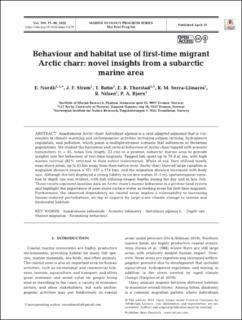Behaviour and habitat use of first-time migrant Arctic charr: novel insights from a subarctic marine area
Nordli, Eivind; Strøm, John Fredrik; Bøhn, Thomas; Thorstad, Eva Bonsak; Serra Llinares, Rosa Maria; Nilsen, Rune; Bjørn, Pål Arne
Peer reviewed, Journal article
Published version

Åpne
Permanent lenke
https://hdl.handle.net/11250/3075522Utgivelsesdato
2023Metadata
Vis full innførselSamlinger
- Publikasjoner fra CRIStin - NINA [2397]
- Scientific publications [1423]
Sammendrag
Anadromous Arctic charr Salvelinus alpinus is a cold-adapted salmonid that is vul nerable to climate warming and anthropogenic activities including salmon farming, hydropower
regulation, and pollution, which poses a multiple-stressor scenario that influences or threatens
populations. We studied the horizontal and vertical behaviour of Arctic charr tagged with acoustic
transmitters (n = 45, mean fish length: 22 cm) in a pristine, subarctic marine area to provide
insights into the behaviour of first-time migrants. Tagged fish spent up to 78 d at sea, with high
marine survival (82% returned to their native watercourse). While at sea, they utilized mostly
near-shore areas, up to 45 km away from their native river. Arctic charr showed large variation in
migration distance (mean ± SD: 222 ± 174 km), and the migration distance increased with body
size. Although the fish displayed a strong fidelity to surface waters (0−3 m), spatiotemporal varia tion in depth use was evident, with fish utilizing deeper depths during the day and in late July.
These results represent baseline data on Arctic charr’s marine behaviour in a pristine fjord system
and highlight the importance of near-shore surface water as feeding areas for first-time migrants.
Furthermore, the observed dependency on coastal areas implies a vulnerability to increasing
human-induced perturbations, on top of impacts by large-scale climate change in marine and
freshwater habitats.
